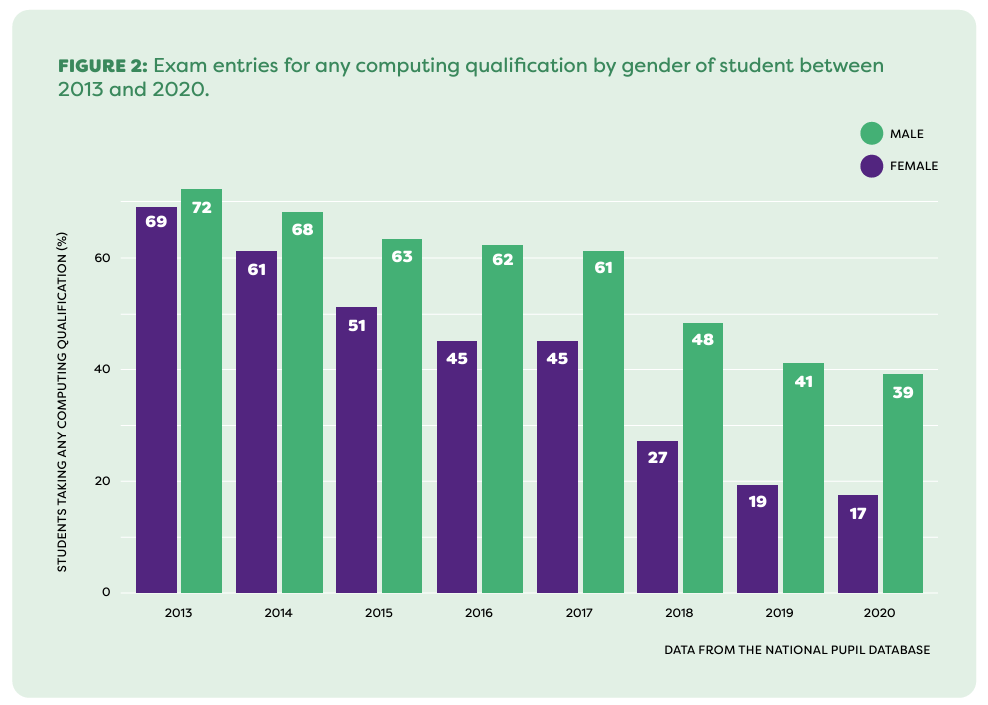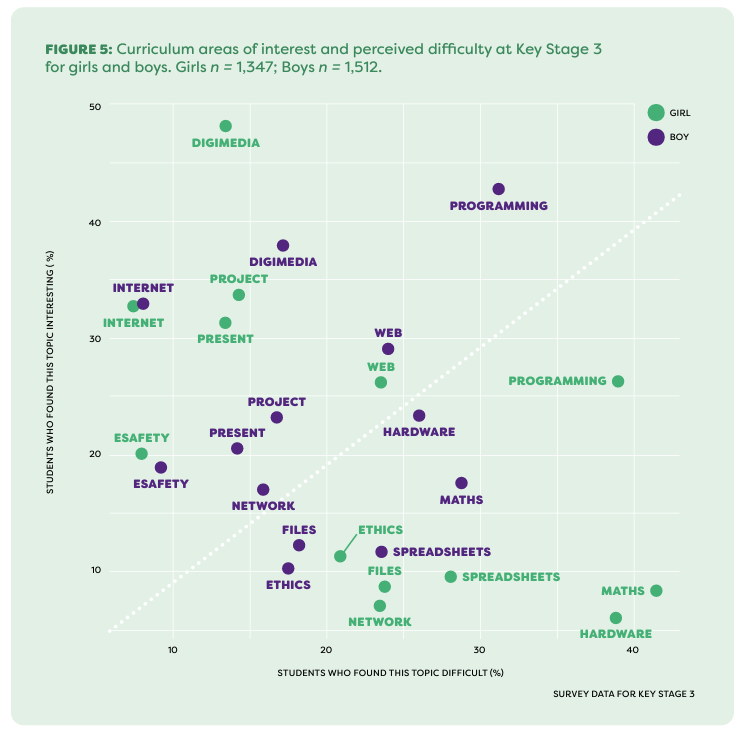Background
On 27th June, Rebecca Franks was invited to the launch of the report from the SCARI computing project. The report is a culmination of a three year long project to dig into the data to establish a picture of the state of computing education in England. You can view the whole report and the other mini reports on the dedicated King’s College Website here: https://www.kcl.ac.uk/research/subject-choice-attainment-and-representation-in-computing
Below are Rebecca Franks thoughts on the impact of moving from ICT to Computer Science and what we can do to create lasting change in our systems.

The Shift from ICT to Computer Science
When GCSE ICT was scrapped and replaced with GCSE Computer Science, I found it baffling. The English National Curriculum for Computing still includes ‘IT’ in its purpose of study, aims, and attainment targets for all key stages. IT didn’t go away. However, there is no GCSE option that allows students to further their IT skills after Key Stage 3 (age 14).
The Problem with the Current System
I’m not saying we should have kept the ICT GCSE as it was—it had its flaws. However, the lack of any GCSE choice makes it difficult for students to advance unless they opt for the highly theoretical Computer Science GCSE. Many educators discussed why this change happened, suspecting it might be due to the perception of ICT as an ‘easy’ qualification and the desire to introduce a more rigorous standard.
Findings from the SCARI Project
The SCARI project has revealed that this change has had a devastating impact on making computing accessible and inspirational to a wide range of learners.
Gender Disparity in Exam Entries
Exam entries have reduced overall, and there’s been a significant impact on the gender balance, with girls being particularly discouraged from pursuing computing. Several factors contribute to this issue.

Challenges Faced by Girls in Computing
Difficulty of the Subject
GCSE Computer Science is one of the most difficult GCSEs, second only to GCSE Statistics. Girls, being aware of the statistical difficulty, might avoid a subject where they are likely to perform worse than in any other GCSE.
Lack of Qualified Teachers and Curriculum Time
The shortage of qualified computing teachers and limited curriculum time at KS3 make it hard for girls to develop an interest in computing. Many girls who become interested in computing have been inspired by parents or great teachers early on. Without these experiences, they may not see themselves in computing.
Early Disengagement
The saying “Year 8 is too late” highlights that if girls haven’t had positive computing experiences by then, their interest is unlikely to develop. Many who were interested in primary school lose interest before reaching their GCSE options.
Factors Contributing to Disengagement
Stereotypes, classroom misogyny, lack of engaging experiences, and a focus on theoretical aspects over real-world applications contribute to girls’ disinterest in computing. The current approach to teaching, which emphasises exam preparation*, fails to show the real-world relevance of computing.
*because of the system
Personal Experience with Coding
Although I enjoyed playing with LOGO on the BBC micro and learning Pascal in college, coding didn’t feel truly real to me until I used Visual Basic to create a maths teaching program to help with my exams. Later, I discovered Flash ActionScript 3.0, which offered a practical and engaging way to create fun mini games that worked directly in the browser.
Most KS3 learners are introduced to Python. While Python is a powerful language, its text-based nature can make it harder for students to see the immediate, real-world applications of what they’re learning. Real-world tools like Unity and UEFN can create immersive experiences but require decent equipment and come with age restrictions. These are challenges that can be addressed, and I hope to see more schools adopting these tools in the future.
The Need for IT in the Curriculum
IT has been sidelined due to the curriculum’s narrow focus at GCSE. There’s too much emphasis on coding concepts rather than problem-solving and creativity. While coding concepts are important, we should prioritise real-world problem-solving skills. With generative AI, knowing what code is needed is more critical than writing it from scratch.
Reforming the Curriculum
The SCARI report recommends reforming the computing curriculum. However, this shouldn’t lead to gender-segregated GCSEs. We need a more rounded curriculum that includes creative applications of computer science. Computing should be treated as a practical subject with real-world problem-solving at its core.
Essential Digital Skills for All
Everyone needs digital skills, just like English and Maths. We need a qualification that ensures young people can adapt to new technologies, understand the ethics behind them, and use them safely. Inclusion must be at the heart of this reform, involving a diverse range of people in decision-making.
Exploring Inclusive Learning Opportunities
Looking at the SCARI report’s graph on curriculum areas of interest and perceived difficulty (below) at Key Stage 3, web development stands out as an inclusive and accessible way to teach computing. Starting with HTML and CSS and progressing to JavaScript, web development requires minimal equipment and directly connects to the real world. This approach could be a gateway to engaging more students in computing.

Conclusion
The shift from ICT to Computer Science GCSE has had unintended consequences, particularly for girls. To make computing accessible and relevant, we need a curriculum that emphasises real-world problem-solving and creativity. Ensuring that all students leave school with essential digital skills is crucial for their future success.

0 Comments